Evaluation of the Residual Seismic Capacity of Post-Earthquake Damaged RC Columns Based on the Damage Distribution Model
Abstract
1. Introduction
2. Analysis Method of the RSC of Post-Earthquake Damaged RC Columns
2.1. Overview of Methodology
2.2. Quantification of Damage to Columns
2.2.1. Estimation of Damage Degree
2.2.2. Damage Distribution of Materials
2.3. Numerical Model
2.4. Evaluation of Residual Seismic Capacity
2.4.1. Incremental Dynamic Analysis
2.4.2. Ultimate Drift Ratio of Damaged Columns
2.4.3. Collapse Fragility of Damaged Column
3. Example Application and Discussions
3.1. Test Database of RC Columns
3.2. Validation of the Numerical Model
3.3. Residual Collapse Capacity of Post-Earthquake Damaged Columns
4. Effect of Structural Parameters on Degradation of Collapse Capacity of Damaged Columns
4.1. Collapse Fragility Index of Damaged Columns
4.2. Structural Parameter Analysis
4.3. Establishment of Empirical Model
5. Conclusions
- (1)
- Based on the actual post-earthquake damage phenomenon and the damage distribution model, the simulation method of earthquake-damaged columns was suggested. Forty-one specimens were selected from the PEER database to verify the proposed numerical model. The results show that the proposed numerical model can accurately predict the residual load–displacement response of RC columns under different damage states.
- (2)
- Twenty-one ground motion records were selected for collapse fragility analysis of the numerical models of 41 specimens under different damage states. The fragility analysis results revealed that the higher the degree of main shock damage, the lower the residual collapse capacity. In addition, the 90% fractional line of the difference between aftershock collapse probability and main shock collapse probability of structures with different damage degrees was discussed. It is concluded that the RC column in the slightly damaged state has a 90% probability of not collapsing after aftershocks, and RC columns with moderate damage will collapse only under the action of strong aftershocks. For RC columns in severe and extremely damaged states, collapse will occur at low aftershock levels.
- (3)
- The CFI was calculated based on the fragility results. The mean values of the CFI for the slight, moderate, severe, and extreme damage states are 0.86, 0.71, 0.58, and 0.48, respectively. This shows that the risk of collapse of the structure increases significantly with the increase in the degree of damage. The two parameters with the greatest influence on the CFI were I1 and DI, as determined by parametric analysis. The empirical model of CFI related to I1 and DI is fitted. The fitted empirical model can effectively predict the degradation of the residual collapse capacity of damaged RC columns in different damage states (r = 0.82).
- (4)
- The method outlined in this paper can evaluate the RSC of columns based on the actual post-earthquake damage phenomenon. If the damage strain distribution of post-earthquake damaged columns can be quantified based on damage images and combined with computer vision and unmanned aerial vehicle technology, the efficiency of the evaluators can be greatly improved.
Author Contributions
Funding
Data Availability Statement
Conflicts of Interest
Appendix A. Parameters of Test Specimen Used in this Research (Table A1)
| Specimen | b (mm) | h (mm) | H (mm) | c (mm) | d1 (mm) | d2 (mm) | fc (Mpa) | fy (Mpa) | fyv (Mpa) | n0 (%) | rv (%) | θu (%) |
|---|---|---|---|---|---|---|---|---|---|---|---|---|
| Ang. No.3 | 400 | 400 | 1600 | 24.5 | 16 | 12 | 23.6 | 427 | 320 | 0.38 | 2.8 | 3.12 |
| Ang. No.4 | 400 | 400 | 1600 | 22.5 | 16 | 10 | 25 | 427 | 280 | 0.21 | 2.2 | 3.62 |
| Soes. No.1 | 400 | 400 | 1600 | 13 | 16 | 7 | 46.5 | 446 | 364 | 0.1 | 0.9 | 6.25 |
| Soes. No.2 | 400 | 400 | 1600 | 13 | 16 | 8 | 44 | 446 | 360 | 0.3 | 1.2 | 5.3 |
| Soes. No.3 | 400 | 400 | 1600 | 13 | 16 | 7 | 44 | 446 | 364 | 0.3 | 0.8 | 2.8 |
| Soes. No.4 | 400 | 400 | 1600 | 13 | 16 | 6 | 40 | 446 | 255 | 0.3 | 0.6 | 2.8 |
| Watson. No.5 | 400 | 400 | 1600 | 13 | 16 | 8 | 41 | 474 | 372 | 0.5 | 0.7 | 2.5 |
| Watson. No.6 | 400 | 400 | 1600 | 13 | 16 | 6 | 40 | 474 | 388 | 0.5 | 0.3 | 1.5 |
| Watson. No.7 | 400 | 400 | 1600 | 13 | 16 | 12 | 42 | 474 | 308 | 0.7 | 1.3 | 1.12 |
| Watson. No.8 | 400 | 400 | 1600 | 13 | 16 | 8 | 39 | 474 | 372 | 0.7 | 0.7 | 1.12 |
| Watson. No.9 | 400 | 400 | 1600 | 13 | 16 | 12 | 40 | 474 | 308 | 0.7 | 2.3 | 2.68 |
| Tanaka. No.1 | 400 | 400 | 1600 | 40 | 20 | 12 | 25.6 | 474 | 333 | 0.2 | 2.5 | 3.5 |
| Tanaka. No.5 | 550 | 550 | 1650 | 40 | 20 | 12 | 32 | 511 | 325 | 0.1 | 1.7 | 6 |
| Tanaka. No.7 | 550 | 550 | 1650 | 40 | 20 | 12 | 32.1 | 511 | 325 | 0.3 | 2.1 | 5 |
| Ohno. L3 | 400 | 400 | 1600 | 31.5 | 19 | 9 | 24.8 | 362 | 325 | 0.032 | 0.3 | 4.6 |
| Atalay. No.1S1 | 305 | 305 | 1676 | 32 | 22 | 9.5 | 29.1 | 367 | 363 | 0.099 | 1.8 | 6 |
| Atalay. No.2S1 | 305 | 305 | 1676 | 32 | 22 | 9.5 | 30.7 | 367 | 363 | 0.093 | 1.5 | 4.8 |
| Atalay. No.4S1 | 305 | 305 | 1676 | 32 | 22 | 9.5 | 27.6 | 429 | 363 | 0.104 | 0.9 | 5.3 |
| Atalay. No.5S1 | 305 | 305 | 1676 | 32 | 22 | 9.5 | 29.4 | 429 | 392 | 0.195 | 0.9 | 6 |
| Atalay. No.6S1 | 305 | 305 | 1676 | 32 | 22 | 9.5 | 31.8 | 429 | 392 | 0.181 | 1.5 | 4.8 |
| Atalay. No.9 | 305 | 305 | 1676 | 32 | 22 | 9.5 | 33.3 | 363 | 392 | 0.259 | 0.9 | 3.03 |
| Atalay. No.10 | 305 | 305 | 1676 | 32 | 22 | 9.5 | 32.4 | 363 | 392 | 0.266 | 1.5 | 3.03 |
| Azizinamini. NC-2 | 457 | 457 | 1372 | 38.1 | 25.4 | 12.7 | 39.3 | 439 | 454 | 0.206 | 0.9 | 4.7 |
| Azizinamini. NC-4 | 457 | 457 | 1372 | 41.3 | 25.4 | 9.5 | 39.8 | 439 | 616 | 0.31 | 2.2 | 2.9 |
| Wehbe. A1 | 380 | 610 | 2335 | 28 | 19.1 | 6 | 27.2 | 448 | 428 | 0.098 | 1.9 | 5.2 |
| Wehbe. A2 | 380 | 610 | 2335 | 28 | 19.1 | 6 | 27.2 | 448 | 428 | 0.239 | 0.4 | 5.2 |
| Wehbe. B1 | 380 | 610 | 2335 | 25 | 19.1 | 6 | 28.1 | 448 | 428 | 0.092 | 0.4 | 6.85 |
| Wehbe. B2 | 380 | 610 | 2335 | 25 | 19.1 | 6 | 28.1 | 448 | 428 | 0.232 | 0.5 | 4.83 |
| Lynn. 2CLH18 | 457.2 | 457.2 | 1473 | 38.1 | 25.4 | 9.5 | 33.1 | 331 | 299 | 0.073 | 0.5 | 2 |
| Lynn. 2CMH18 | 457.2 | 457.2 | 1473 | 38.1 | 25.4 | 9.5 | 25.5 | 331 | 399 | 0.284 | 0.2 | 1 |
| Saatcioglu. BG-1 | 350 | 350 | 1645 | 29 | 19.5 | 9.5 | 34 | 455.6 | 570 | 0.428 | 0.2 | 3.04 |
| Saatcioglu. BG-2 | 350 | 350 | 1645 | 29 | 19.5 | 9.5 | 34 | 455.6 | 570 | 0.428 | 1 | 5 |
| Saatcioglu. BG-3 | 350 | 350 | 1645 | 29 | 19.5 | 9.5 | 34 | 455.6 | 570 | 0.2 | 2 | 7 |
| Saatcioglu. BG-4 | 350 | 350 | 1645 | 29 | 19.5 | 9.5 | 34 | 455.6 | 570 | 0.462 | 2 | 4.86 |
| Saatcioglu. BG-5 | 350 | 350 | 1645 | 29 | 19.5 | 9.6 | 34 | 455.6 | 570 | 0.462 | 1.3 | 6 |
| Saatcioglu. BG-8 | 350 | 350 | 1645 | 29 | 19.5 | 6.6 | 34 | 455.6 | 580 | 0.231 | 2.7 | 7 |
| Mo. C1–1 | 400 | 400 | 1400 | 34 | 19 | 6.3 | 24.9 | 497 | 459 | 0.113 | 1.3 | 6.3 |
| Mo. C1–2 | 400 | 400 | 1400 | 34 | 19 | 6.3 | 26.7 | 497 | 459 | 0.158 | 1.5 | 6.7 |
| Mo. C1–3 | 400 | 400 | 1400 | 34 | 19 | 6.3 | 26.1 | 497 | 459 | 0.216 | 1.5 | 6.65 |
| Takemura. Test1 | 400 | 400 | 1245 | 27.5 | 12.7 | 6 | 35.9 | 363 | 368 | 0.027 | 1.5 | 3.5 |
| Takemura. Test2 | 400 | 400 | 1245 | 27.5 | 12.7 | 6 | 35.7 | 363 | 368 | 0.027 | 0.5 | 5.6 |
References
- Applied Technology Council. ATC-20 Procedures for Post-Earthquake Building Safety Evaluation Procedures; Applied Technology Council (ATC): Redwood City, CA, USA, 1995. [Google Scholar]
- GB/T 24335−2009; Classification of Earthquake Damaged Buildings and Special Structures. Standards Press of China: Beijing, China, 2009.
- Mitrani-Resier, J.; Wu, S.; Beck, J.L. Virtual inspector and its application to immediate pre-event and post-event earthquake loss and safety assessment of buildings. Nat. Hazards 2016, 81, 1861–1878. [Google Scholar] [CrossRef]
- Anagnostopoulos, S.; Moretti, M. Post-earthquake emergency assessment of building damage, safety and usability—Part 1: Technical issues. Soil Dyn. Earthq. Eng. 2008, 28, 223–232. [Google Scholar] [CrossRef]
- Cheng, B.; Chang, R.; Yin, Q.; Li, J.; Huang, J.; Chen, H. A PSR-AHP-GE model for evaluating environmental impacts of spoil disposal areas in high-speed railway engineering. J. Clean. Prod. 2023, 388, 135970. [Google Scholar] [CrossRef]
- Qu, B.W.; Zhang, H.Y.; Mao, C.X. Quantitative seismic damage assessment method for reinforced concrete frame column. Word Earthq. Eng. 2018, 34, 85–93. [Google Scholar]
- Fu, H.; Niu, J.; Wu, Z.; Cheng, B.; Guo, X.; Zuo, J. Exploration of public stereotypes of supply-and-demand characteristics of recycled water infrastructure—Evidence from an event-related potential experiment in Xi’an, China. J. Environ. Manag. 2022, 322, 116103. [Google Scholar] [CrossRef]
- Valente, M.; Milani, G. Alternative retrofitting strategies to prevent the failure of an under-designed reinforced concrete frame. Eng. Fail. Anal. 2018, 89, 271–285. [Google Scholar] [CrossRef]
- Valente, M.; Milani, G. Advanced numerical insights into failure analysis and strengthening of monumental masonry churches under seismic actions. Eng. Fail. Anal. 2019, 103, 410–430. [Google Scholar] [CrossRef]
- Valente, M.; Barbieri, G.; Biolzi, L. Seismic assessment of two masonry Baroque churches damaged by the 2012 Emilia earthquake. Eng. Fail. Anal. 2017, 79, 773–802. [Google Scholar] [CrossRef]
- Miao, Z.; Ji, X.; Wu, M.; Gao, X. Deep learning-based evaluation for mechanical property degradation of seismically damaged RC columns. Earthq. Eng. Struct. Dyn. 2022, 1–22. [Google Scholar] [CrossRef]
- FEMA 306; Evaluation of Earthquake Damaged Concrete and Masonry Wall Buildings: Basic Procedures557 Manual. Federal Emergency Management Agency: Washington, DC, USA, 1998.
- Trevlopoulos, K.; Gueguen, P. Period elongation-based framework for operative assessment of the variation of seismic vulnerability of reinforced concrete buildings during aftershock sequences. Soil Dyn. Earthq. Eng. 2016, 84, 224–237. [Google Scholar] [CrossRef]
- Burton, H.V.; Deierlein, G.G. Integrating visual damage simulation, virtual inspection, and collapse capacity to evaluate post-earthquake structural safety of buildings. Earthq. Eng. Struct. Dyn. 2018, 47, 294–310. [Google Scholar] [CrossRef]
- Shokrabadi, M.; Burton, H.V. Risk-based assessment of aftershock and mainshock-aftershock seismic performance of reinforced concrete frames. Struct. Saf. 2018, 73, 64–74. [Google Scholar] [CrossRef]
- Abdelnaby, A.E. Fragility curves for RC frames subjected to Tohoku mainshock-aftershocks sequences. J. Earthq. Eng. 2018, 22, 902–920. [Google Scholar] [CrossRef]
- Raghunandan, M.; Liel, A.B.; Luco, N. Aftershock collapse vulnerability assessment of reinforced concrete frame structures. Earthq. Eng. Struct. Dyn. 2015, 44, 419–439. [Google Scholar] [CrossRef]
- Di Trapani, F.; Malavisi, M. Seismic fragility assessment of infilled frames subject to mainshock/aftershock sequences using a double incremental dynamic analysis approach. Bull. Earthq. Eng. 2019, 17, 211–235. [Google Scholar] [CrossRef]
- Iervolino, I.; Chioccarelli, E.; Suzuki, A. Seismic damage accumulation in multiple mainshock–aftershock sequences. Earthq. Eng. Struct. Dyn. 2020, 49, 1007–1027. [Google Scholar] [CrossRef]
- Furtado, A.; Rodrigues, H.; Varum, H.; Arêde, A. Mainshock-aftershock damage assessment of infilled RC structures. Eng. Struct. 2018, 175, 645–660. [Google Scholar] [CrossRef]
- Lu, X.; Cheng, Q.; Xu, Z.; Xiong, C. Regional seismic-damage prediction of buildings under mainshock-aftershock sequence. Front. Eng. Manag. 2021, 8, 122–134. [Google Scholar] [CrossRef]
- Liao, W.; Fei, Y.; Ghahari, F.; Zhang, W.; Chen, P.Y.; Kurtulus, A.; Yen, C.H.; Cheng, Q.; Lu, X.; Taciroglu, E. Influence of accelerometer type on uncertainties in recorded ground motions and seismic damage assessment. Bull. Earthq. Eng. 2022, 20, 4419–4439. [Google Scholar] [CrossRef]
- FEMA-P695; Quantification of Building Seismic Performance Factors. Applied Technology Council; Federal Emergency Management Agency: Washington DC, USA, 2009.
- Shafei, B.; Zareian, F.; Lignos, D. A simplified method for collapse capacity assessment of moment-resisting frame and shear wall structural systems. Eng. Struct. 2011, 33, 1107–1116. [Google Scholar] [CrossRef]
- Park, Y.J.; Ang, A.H. Mechanistic seismic damage model for reinforced concrete. J. Struct. Eng. 1985, 4, 722–739. [Google Scholar] [CrossRef]
- Li, L.; Luo, G.X.; Wang, Z.H.; Zhang, Y.X.; Zhuge, Y. Prediction of residual behaviour for post-earthquake damaged reinforced concrete column based on damage distribution model. Eng. Struct. 2021, 234, 111927. [Google Scholar] [CrossRef]
- Kent, D.C.; Park, R. Flexural members with confined concrete. J. Struct. Div. 1971, 97, 1969–1990. [Google Scholar] [CrossRef]
- Mander, J.B.; Priestley, M.J.N.; Park, R. Theoretical stress–strain model for confined concrete. J. Struct. Eng. 1988, 114, 1804–1826. [Google Scholar] [CrossRef]
- Feng, D.C.; Cao, X.Y.; Wang, D.; Wu, G. A PDEM-based non-parametric seismic fragility assessment method for RC structures under non-stationary ground motions. J. Build. Eng. 2023, 63, 105465. [Google Scholar] [CrossRef]
- Zhou, Y.; Chen, L.Z.; Long, L. Modeling cyclic behavior of squat reinforced concrete walls exposed to acid deposition. J. Build. Eng. 2023, 63, 105432. [Google Scholar] [CrossRef]
- ASCE/SEI 41-13; Seismic Evaluation and Retrofit of Existing Buildings. Engineers AmS O C: Reston, VI, USA, 2014.
- Melchers, R.E. Structural Reliability: Analysis and Prediction, 2nd ed.; John Wiley & Sons: New York, NY, USA, 1999. [Google Scholar]
- Ang, B.G.; Priestley, M.J.N.; Park, N. Ductility of Reinforced Bridge Piers under Seismic Loading. Master’s Thesis, University of Canterbury, Canterbury, New Zealand, 1981. [Google Scholar] [CrossRef]
- Soesianawati, M.T. Limited Ductility Design of Reinforced Concrete Columns. Master’s Thesis, University of Canterbury, Canterbury, New Zealand, 1986. [Google Scholar] [CrossRef]
- Watson, S. Design of Reinforced Concrete Frames of Limited Ductility. Ph.D. Thesis, University of Canterbury, Canterbury, New Zealand, 1989. [Google Scholar] [CrossRef]
- Tanaka, H. Effect of Lateral Confining Reinforcement on the Ductile Behaviour of Reinforced Concrete Columns. Ph.D. Thesis, University of Canterbury, Canterbury, New Zealand, 1990. [Google Scholar] [CrossRef]
- Ohno, T.; Nishioka, Y. An Experimental Study on Energy Absorption Capacity of Columns in Reinforced Concrete Structures. Doboku Gakkai Ronbunshu 1984, 1984, 23–33. [Google Scholar] [CrossRef]
- Atalay, M.B.; Penzien, J. The Seismic Behavior of Critical Regions of Reinforced Concrete Components as Influenced by Moment, Shear and Axial Force; Earthquake Engineering Research Center, University of California: Berkeley, CA, USA, 1975. [Google Scholar]
- Azizinamini, A.; Corley, W.G.; Johal, L.P. Effects of Transverse Reinforcement on Seismic Performance of Columns. Aci Struct. J. 1992, 89, 442–450. [Google Scholar] [CrossRef]
- Wehbe, N. EERI Annual Student Paper Award Confinement of Rectangular Bridge Columns in Moderate Seismic Areas. Earthq. Spectra 1998, 14, 397–406. [Google Scholar] [CrossRef]
- Lynn, A.C.; Moehle, J.P.; Mahin, S.A.; Holmes, W.T. Seismic Evaluation of Existing Reinforced Concrete Building Columns. Earthq. Spectra 1996, 12, 715–739. [Google Scholar] [CrossRef]
- Saatcioglu, M.; Grira, M. Confinement of Reinforced Concrete Columns with Welded Reinforced Grids. Aci Struct. J. 1999, 96, 29–39. [Google Scholar] [CrossRef]
- Mo, Y.L.; Wang, S.J. Seismic Behavior of RC Columns with Various Tie Configurations. J. Struct. Eng. 2000, 126, 1122–1130. [Google Scholar] [CrossRef]
- Takemura, H.; Kawashima, K. Effect of loading hysteresis on ductility capacity of reinforced concrete bridge piers. J. Struct. Eng. 1997, 43, 849–858. [Google Scholar]
- Li, L.; Wang, W.T.; Shi, P.P. Modelling catastrophic degradation of flexural-dominated RC columns at ultimate displacements based on fibre beam-column model. J. Build. Eng. 2022, 45, 103476. [Google Scholar] [CrossRef]
- Genest, C.; Favre, A.C. Everything you always wanted to know about copula modeling but were afraid to ask. J. Hydrol. Eng. 2007, 12, 347–368. [Google Scholar] [CrossRef]
- Cheng, B.; Fu, H.; Li, T. Evolutionary computation-based multitask learning network for railway passenger comfort evaluation from EEG signals. Appl. Soft Comput. 2023, 136, 110079. [Google Scholar] [CrossRef]
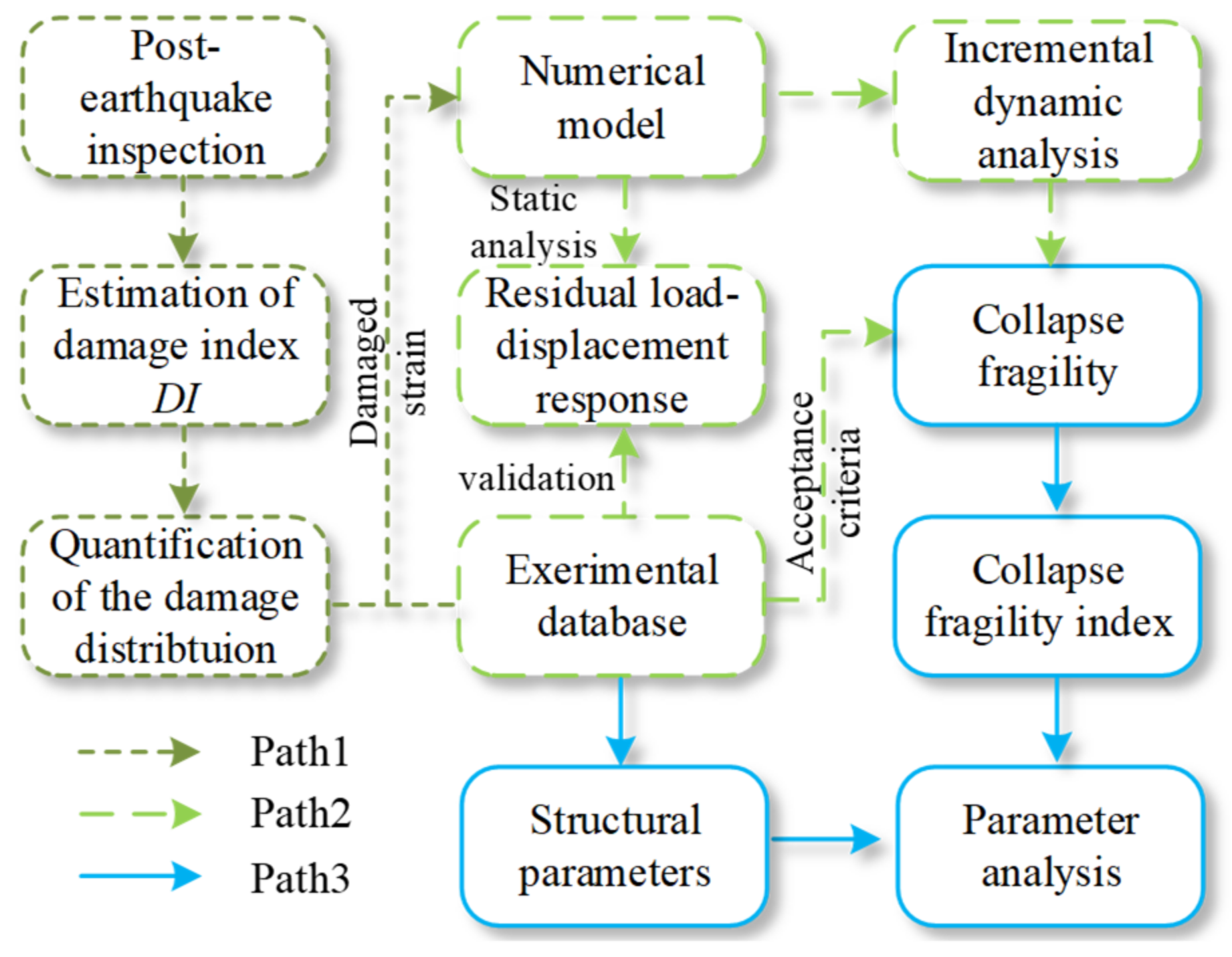

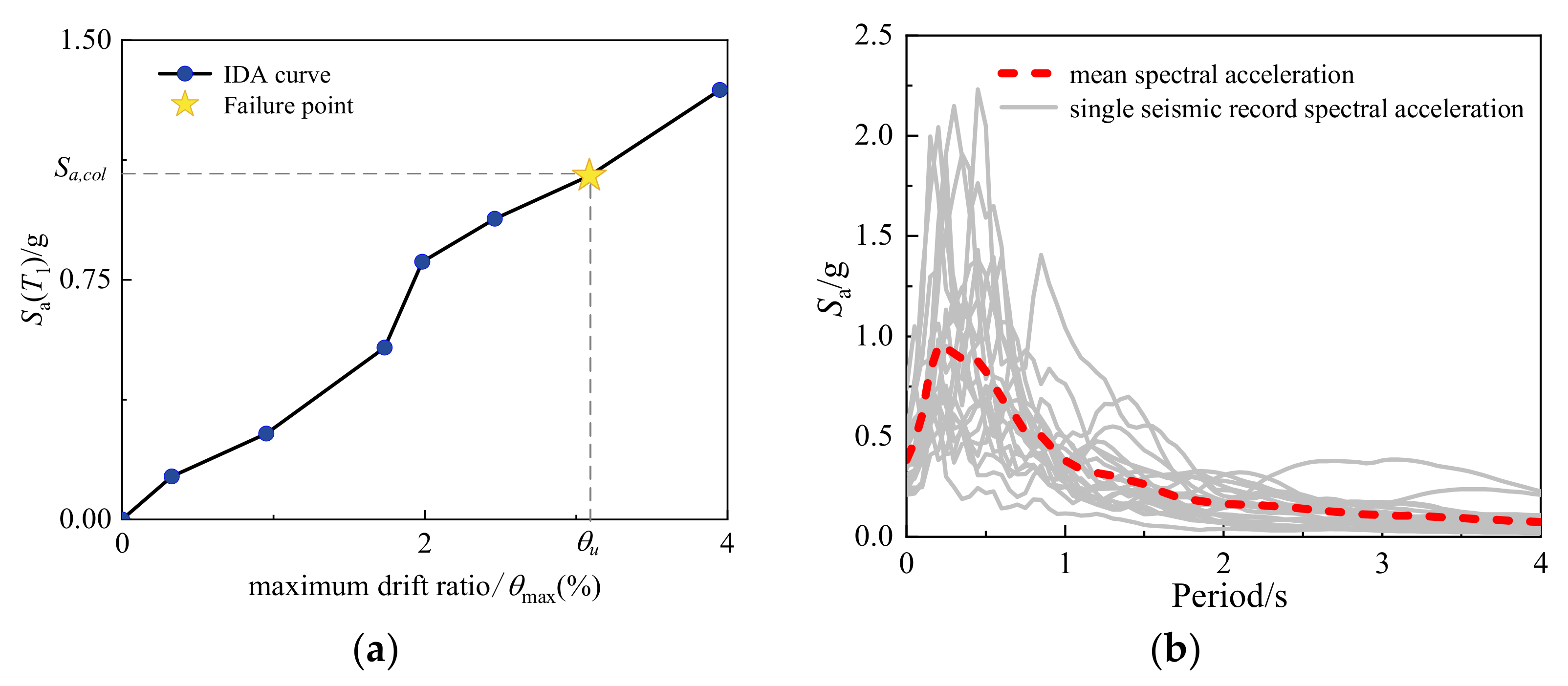
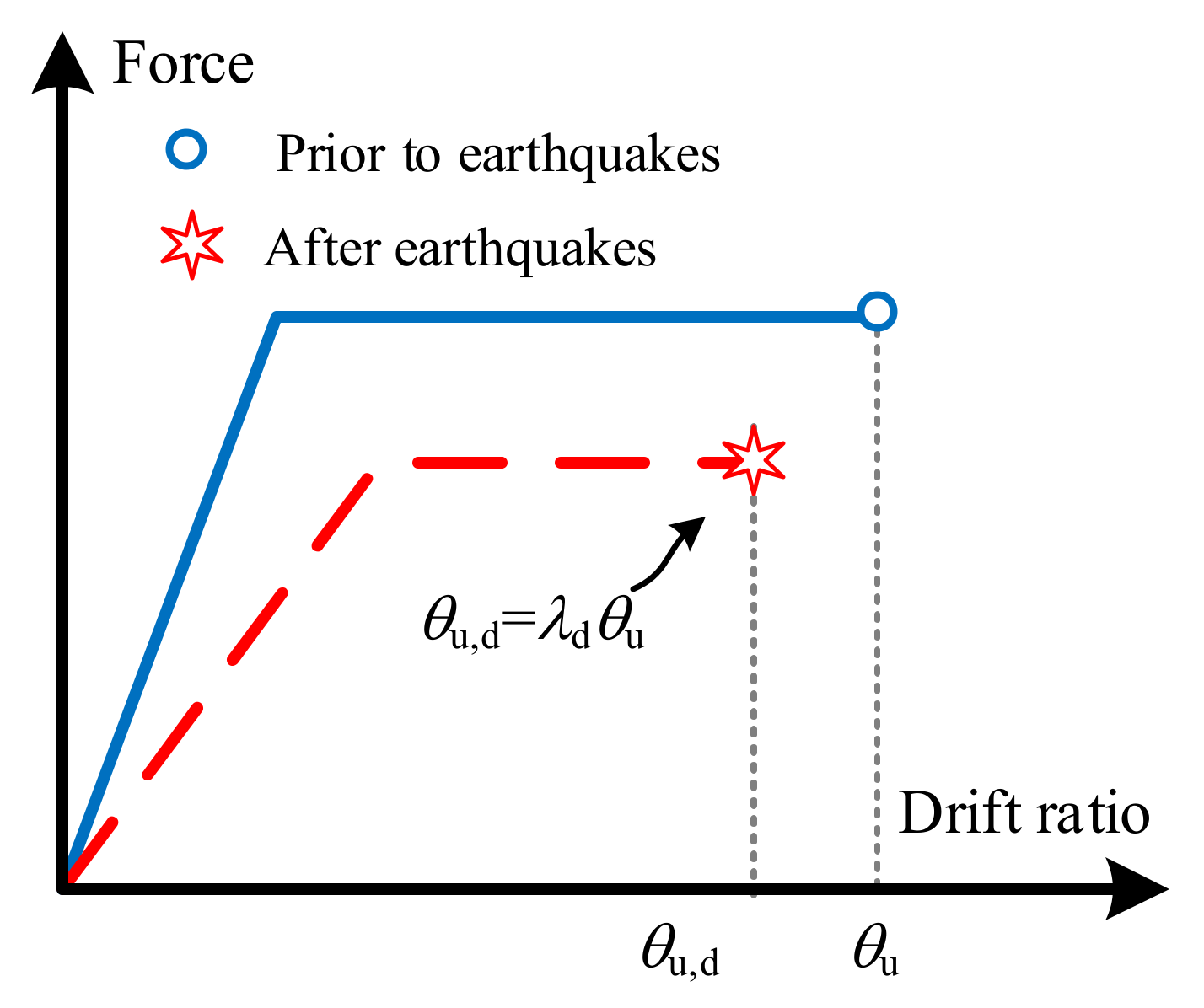
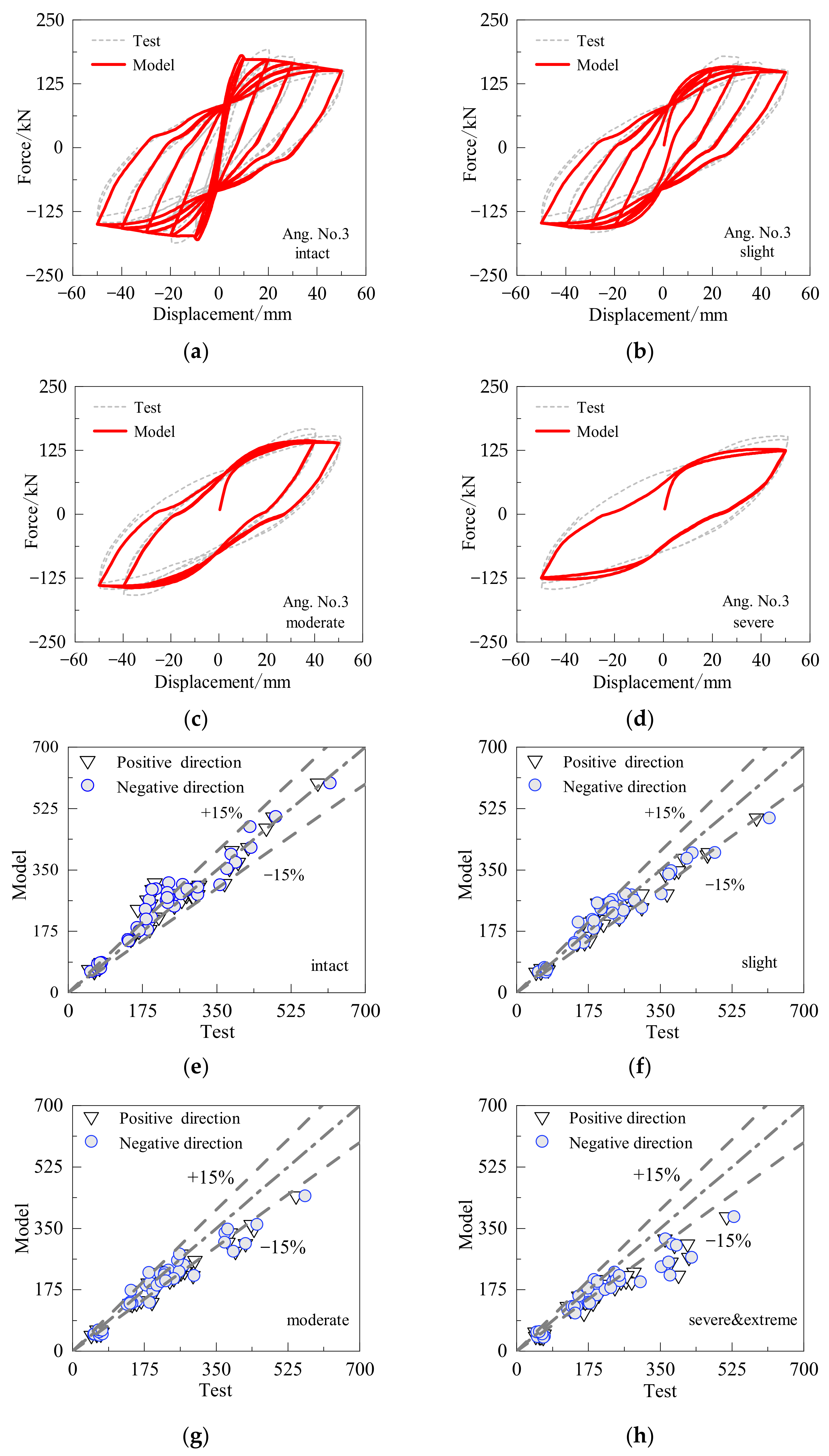



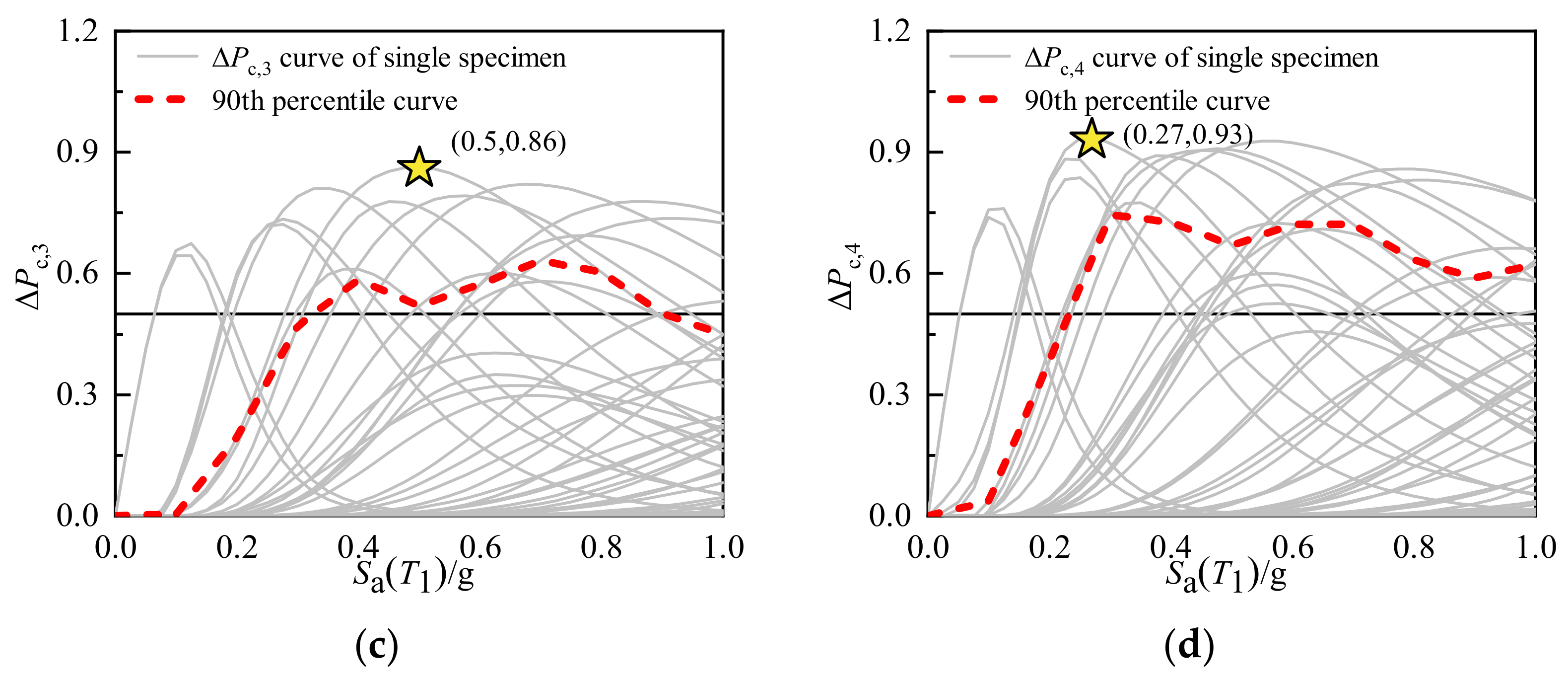




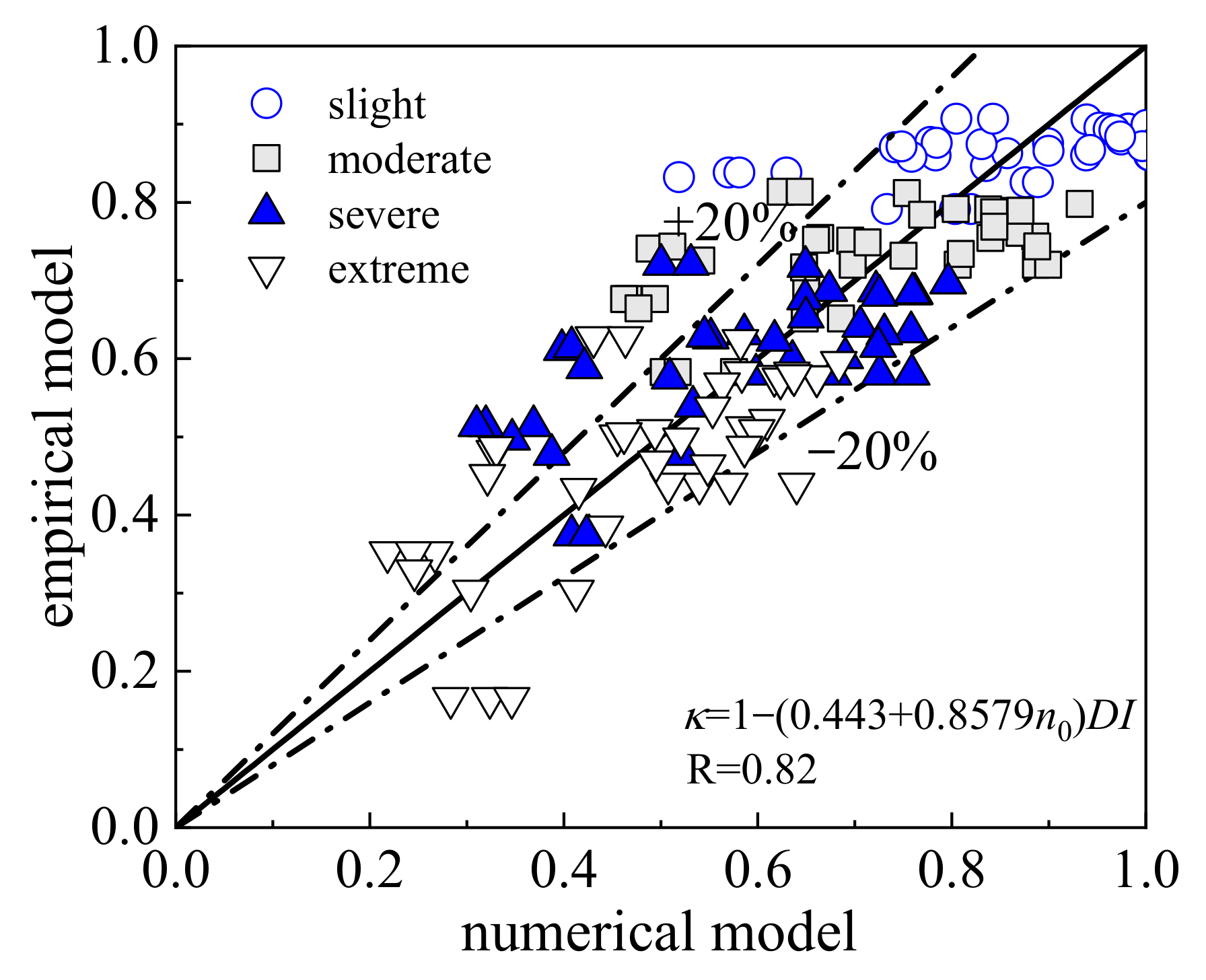
| Ref. | Specimen | εcc,d (%) | εccu (%) | |||
|---|---|---|---|---|---|---|
| Slight Damage | Moderate Damage | Severe Damage | Extreme Damage | |||
| [33] | Ang. No.3 | 1.24 | 3.51 | 14.88 | 84.1 | 7.67 |
| Ang. No.4 | 0.95 | 2.67 | 11.33 | 64.03 | 5.6 | |
| [34] | Soes. No.1 | 0.54 | 1.52 | 6.43 | 36.31 | 2.64 |
| Soes. No.2 | 0.66 | 1.88 | 7.95 | 44.91 | 3.53 | |
| Soes. No.3 | 0.54 | 1.52 | 6.43 | 36.31 | 2.62 | |
| Soes. No.4 | 0.42 | 1.2 | 5.07 | 28.67 | 1.7 | |
| [35] | Watson. No.5 | 0.69 | 1.96 | 8.29 | 46.83 | 3.68 |
| Watson. No.6 | 0.48 | 1.36 | 5.75 | 32.49 | 2.27 | |
| Watson. No.7 | 0.85 | 2.39 | 10.15 | 57.34 | 5 | |
| Watson. No.8 | 0.73 | 2.08 | 8.79 | 49.69 | 3.3 | |
| Watson. No.9 | 1.4 | 3.95 | 16.74 | 94.61 | 7.42 | |
| [36] | Tanaka. No.1 | 1.24 | 3.51 | 14.88 | 84.1 | 7.58 |
| Tanaka. No.5 | 0.85 | 2.39 | 10.15 | 57.34 | 4.84 | |
| Tanaka. No.7 | 0.97 | 2.75 | 11.67 | 65.94 | 3.3 | |
| [37] | Ohno. L3 | 0.57 | 1.6 | 6.77 | 38.23 | 2.9 |
| [38] | Atalay. No.1S1 | 0.78 | 2.19 | 9.3 | 52.56 | 3.41 |
| Atalay. No.2S1 | 0.51 | 1.44 | 6.09 | 34.4 | 2.38 | |
| Atalay. No.4S1 | 0.54 | 1.52 | 6.43 | 36.31 | 2.57 | |
| Atalay. No.5S1 | 0.81 | 2.27 | 9.64 | 54.47 | 3.57 | |
| Atalay. No.6S1 | 0.52 | 1.48 | 6.26 | 35.36 | 2.45 | |
| Atalay. No.9 | 0.75 | 2.12 | 8.96 | 50.65 | 3.28 | |
| Atalay. No.10 | 0.51 | 1.44 | 6.09 | 34.4 | 2.42 | |
| [39] | Azizinamini. NC-2 | 1.02 | 2.87 | 12.18 | 68.81 | 4.02 |
| Azizinamini. NC-4 | 0.86 | 2.43 | 10.32 | 58.29 | 2.05 | |
| [40] | Wehbe. A1 | 0.48 | 1.36 | 5.75 | 32.49 | 1.84 |
| Wehbe. A2 | 0.48 | 1.36 | 5.75 | 32.49 | 1.84 | |
| Wehbe. B1 | 0.54 | 1.52 | 6.43 | 36.31 | 2.15 | |
| Wehbe. B2 | 0.54 | 1.52 | 6.43 | 36.31 | 2.15 | |
| [41] | Lynn. 2CLH18 | 0.3 | 0.84 | 3.55 | 20.07 | 0.94 |
| Lynn. 2CMH18 | 0.3 | 0.84 | 3.55 | 20.07 | 1.1 | |
| [42] | Saatcioglu. BG-1 | 0.65 | 1.84 | 7.78 | 43.96 | 3.07 |
| Saatcioglu. BG-2 | 1.19 | 3.35 | 14.21 | 80.27 | 4.5 | |
| Saatcioglu. BG-3 | 1.19 | 3.35 | 14.21 | 80.27 | 4.5 | |
| Saatcioglu. BG-4 | 0.79 | 2.23 | 9.47 | 53.52 | 3.7 | |
| Saatcioglu. BG-5 | 1.47 | 4.15 | 17.59 | 99.39 | 5.28 | |
| Saatcioglu. BG-8 | 0.95 | 2.67 | 11.33 | 64.03 | 3.41 | |
| [43] | Mo. C1–1 | 1.19 | 3.35 | 14.21 | 80.27 | 3.95 |
| Mo. C1–2 | 1.13 | 3.19 | 13.53 | 76.45 | 3.78 | |
| Mo. C1–3 | 1.13 | 3.19 | 13.53 | 76.45 | 3.78 | |
| [44] | Takemura. Test1 | 0.45 | 1.28 | 5.41 | 30.58 | 1.28 |
| Takemura. Test2 | 0.45 | 1.28 | 5.41 | 30.58 | 1.28 | |
| Structural Parameters | Slight Damage | Moderate Damage | Severe Damage | Extreme Damage | ||||
|---|---|---|---|---|---|---|---|---|
| r | p-Value | r | p-Value | r | p-Value | r | p-Value | |
| I1 | −0.532 | 0.000 | −0.529 | 0.000 | −0.614 | 0.000 | −0.699 | 0.000 |
| I2 | −0.376 | 0.015 | −0.267 | 0.091 | −0.222 | 0.162 | −0.300 | 0.056 |
| I3 | −0.034 | 0.834 | −0.102 | 0.524 | −0.120 | 0.455 | −0.088 | 0.584 |
| I4 | 0.135 | 0.400 | 0.131 | 0.414 | 0.119 | 0.457 | 0.065 | 0.689 |
| I5 | 0.032 | 0.844 | −0.077 | 0.632 | −0.130 | 0.418 | −0.128 | 0.423 |
| I6 | 0.131 | 0.414 | 0.111 | 0.489 | 0.107 | 0.507 | 0.057 | 0.722 |
Disclaimer/Publisher’s Note: The statements, opinions and data contained in all publications are solely those of the individual author(s) and contributor(s) and not of MDPI and/or the editor(s). MDPI and/or the editor(s) disclaim responsibility for any injury to people or property resulting from any ideas, methods, instructions or products referred to in the content. |
© 2023 by the authors. Licensee MDPI, Basel, Switzerland. This article is an open access article distributed under the terms and conditions of the Creative Commons Attribution (CC BY) license (https://creativecommons.org/licenses/by/4.0/).
Share and Cite
Li, L.; Chen, J.; Wang, W. Evaluation of the Residual Seismic Capacity of Post-Earthquake Damaged RC Columns Based on the Damage Distribution Model. Buildings 2023, 13, 595. https://doi.org/10.3390/buildings13030595
Li L, Chen J, Wang W. Evaluation of the Residual Seismic Capacity of Post-Earthquake Damaged RC Columns Based on the Damage Distribution Model. Buildings. 2023; 13(3):595. https://doi.org/10.3390/buildings13030595
Chicago/Turabian StyleLi, Lei, Jing Chen, and Wentao Wang. 2023. "Evaluation of the Residual Seismic Capacity of Post-Earthquake Damaged RC Columns Based on the Damage Distribution Model" Buildings 13, no. 3: 595. https://doi.org/10.3390/buildings13030595
APA StyleLi, L., Chen, J., & Wang, W. (2023). Evaluation of the Residual Seismic Capacity of Post-Earthquake Damaged RC Columns Based on the Damage Distribution Model. Buildings, 13(3), 595. https://doi.org/10.3390/buildings13030595







